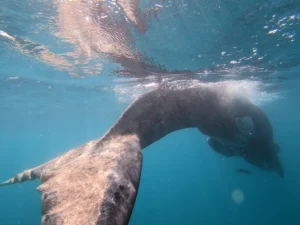Sea pens, belonging to the order Pennatulacea, are a diverse group of colonial cnidarians, consisting of approximately 200 described species found in oceans across the world. Species vary greatly in size, with the aptly named tall sea pen (Funiculina quadrangularis) being the largest among them, exceeding heights of over 2 m. As predominantly benthic creatures, sea pens anchor at various depths, from shallow intertidal zones to hadalpelagic zones at depths of up to 6000 m. While primarily sessile creatures, they are capable of moving to new areas and re-anchoring themselves, and their distribution is largely influenced by environmental factors, such as temperature, light availability, and substrate type.
Named after their semblance to the classical quill pen, these interesting cnidarians exhibit a distinctive morphology characterised by a flexible, elongated central axis, which supports numerous polyps. The polyps are specialised for different functions, including feeding and reproduction. Some species display a vibrant array of colours and bioluminescent capabilities, potentially serving as both a defence mechanism and a means of attracting prey or mates. Sea pens can retract into the substrate when disturbed or threatened and extend back out when conditions are more favourable.
As suspension feeders, sea pens primarily capture zooplankton and detritus from the water column as currents carry suspended particles past them. Specialised feeding polyps, known as autozooids, are equipped with tentacles armed with nematocysts to enable this prey capture. Sea pens are also subject to predation, primarily by sea stars and nudibranchs. The motion of sea pens and the associated flow of water through their colonies contributes to bioturbation, which plays a critical role in the mixing of sediments and nutrients on the seafloor. Through this process, sea pens enhance nutrient cycling and support the overall health of the ecosystem.

The reproductive biology of sea pens varies among species; however, most are gonochoric, with separate male and female individuals. Fertilisation typically occurs in the water column when released gametes come into contact. The resulting embryos develop into planktonic larvae, which eventually settle and metamorphose into sessile polyps. Asexual reproduction is also common, with some sea pens capable of producing new polyps by fragmentation or budding.
Due to their sensitivity to environmental changes such as pollution and habitat disturbance, sea pens can serve as valuable indicators of ecosystem health and the impacts of human activities on the environment. This vulnerability to disturbance makes their presence or absence valuable for assessing the condition of marine ecosystems.
One of the primary threats to sea pens is habitat destruction due to bottom trawling and dredging, which can lead to the physical damage and uprooting of their colonies. Additionally, climate change, with its associated consequences like ocean acidification and rising sea temperatures, can also affect the distribution and survival of sea pens. Efforts to protect and conserve sea pen populations are therefore critical, and the implementation of conservation measures such as the establishment of marine protected areas and sustainable regulated fishing practices, are essential for preserving these unique and ecologically significant organisms.



